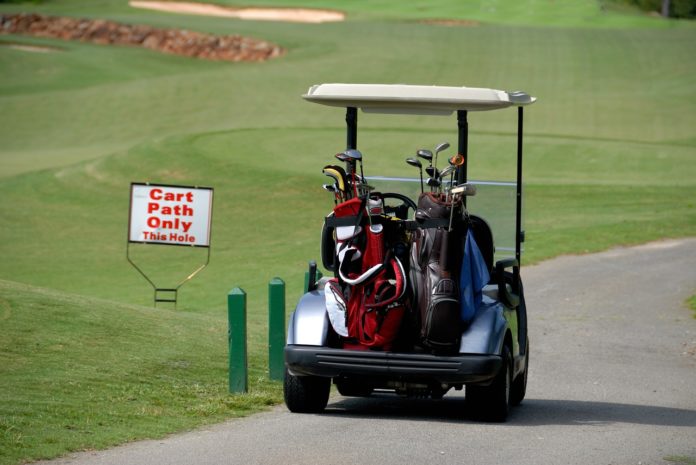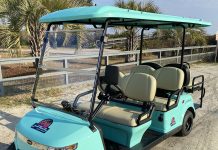
Driving a golf cart is simply not the same as driving an automobile. There are different concerns and potential problems that could lessen your safety on the course. Here are five basic concepts that will keep you rolling down the fairways without worry.
1) Watch Your Speed (Obvious, but We Have to Say It)
The phrase “speed kills” does not normally apply to golf carts on the golf course. Speed, however, is one thing you can concentrate on that will keep you out of harm’s way. Excessive speed in a cart can cause serious injuries.
For example, be especially cautious when driving downhill, especially on a course with a lot of elevation changes. While most carts have a “governor” on the engine to limit top speed, a loaded cart going downhill can gather speed very quickly. There may be a curve or an obstacle along the cart path that can surprise you, and an overly rapid crank of the steering wheel could cause an accident. The same can be said of fairway sand traps. The course designer may have placed one behind a mound to hide it from the tee, but that also makes hard to see as you drive up the fairway. What you see as a nice little hill can lead to a sharp drop over the edge of the trap into a sandy mess.
Speed is also not recommended around the clubhouse. You may really need that hot dog on the turn but a too fast drive into an area crowded with people and other carts could spell disaster, or at least embarrassment. And it means dealing with other cart drivers that could make unsafe moves and cause a collision.
A final consideration is the many obstacles on the course itself. I have seen many carts damaged or totaled because the driver went too fast to avoid things like ball washers, benches, course signs and, of course, large trees. Cart bodies do not react well after being rammed into stationary objects. The cost of playing a round can skyrocket after you crunch the front end of your cart, whether it is a personal ride or one from the course fleet.
2) Consider Gravity when Driving the Golf Cart
Golf carts have a very unusual center of gravity that makes turnovers highly possible. Carts can roll over from being driven across a steep grade or with high speed or both. The aforementioned sand traps can have very slanted edges that can send you on a 90-degree journey if you approach them too closely or with too much speed. In general, the flatter terrain you are navigating, the safer it will be to play the hole. You also have to be careful in areas where there has been excessive water. A heavy cart with two players and two sets of clubs can sink into mud faster than you can say quicksand. Finally, don’t challenge real steep hills. Doing a cart wheelie is playing with fire.
Resource: Find your State’s Golf Cart Laws Here
3) Watch Your Extremities
Arms and legs are necessary when playing golf, and the best place for them when playing is inside the cart. Do you drive with your leg hanging out of the golf cart? If so, you may want to think twice before continuing that habit. I have witnessed many sprains and “emergency room” bone breaks from players who have caught a spike and turned their ankle a way it should not go because it hit an object like a cart path curb. In the extreme, people can be pulled from their carts because their arm or leg wrapped around a pole or post or tree. Trust me, it is hard to pull off a great shot when you are laying on your back.
4) Keep an Eye on Your Clubs
It only takes a minute to assure that your clubs are properly strapped in and secure. There is nothing more annoying than driving down a fairway and hearing the ominous sound of your treasured clubs hitting the deck. I recommend you check a few times during the round to make sure a strap hasn’t slipped and will make you play pick-up sticks while the foursome behind you is derisively laughing.
5) Keep Your Focus
This is an overall approach that will eliminate most of these potential cart safety issues. If you take the same focus you apply to your game and invest it into the manner in which you operate your cart, you will drastically decrease the chance for an accident. You would not drive drunk but driving while you have your brain on pause can produce the same result. Be aware of where you are driving, the speed you are going and the elements of your surroundings. I remember playing on a course right after a big rainstorm and being practically alone. I say practically because when I left the cart to hit a fairway wood I saw a monster mountain lion strolling right across the fairway about 50 yards off. If you run into that situation, feel free to engage whatever warp speed is possible. Stay safe.
Not to negate what I just said, but here is a video for your entertainment. HOPEFULLY it inspires safety:







